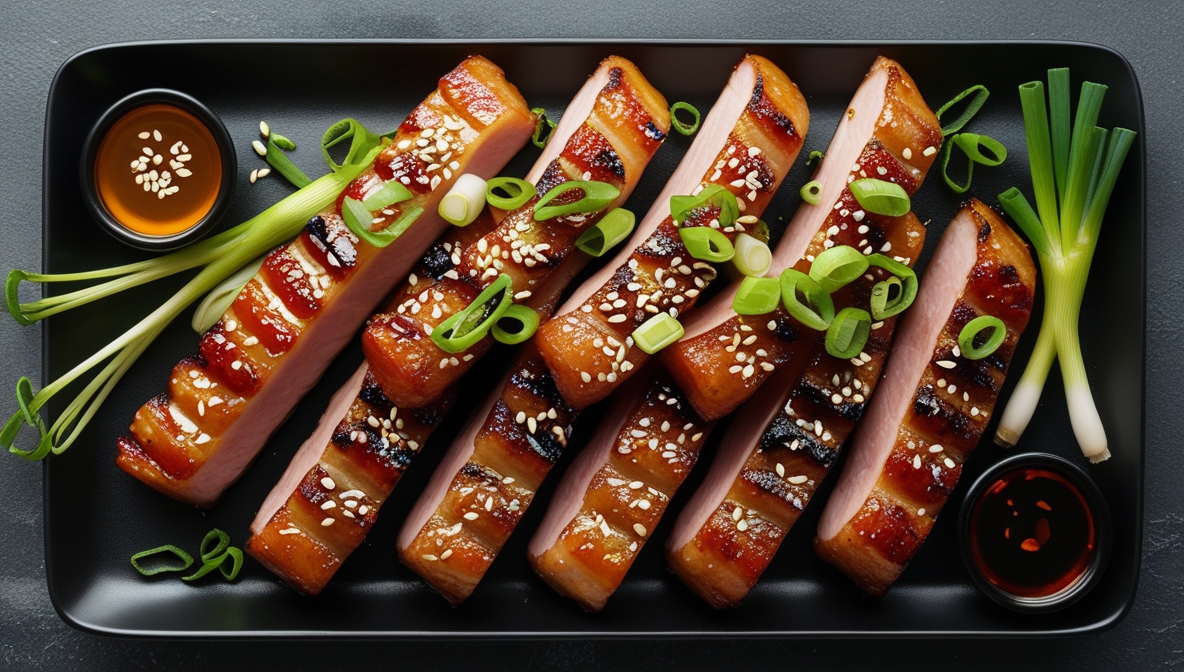Introduction
Samgyeopsal (삼겡살), literally translating to “three-layered flesh,” refers to thick slices of pork belly that are grilled at the table and eaten with various sides and sauces. As one of South Korea’s most beloved dishes, it’s more than just a meal—it’s an experience. Popular among locals and tourists alike, samgyeopsal nights are known for their social, communal, and fun vibe.
Why is it so loved? Its simplicity, rich flavors, and interactive nature make it a staple of Korean dining culture. Few dishes offer the same level of enjoyment, where you cook your own meat, wrap it in lettuce, add sauces, and share it with friends and family.


History & Cultural Significance
While pork has long been consumed in Korea, the modern samgyeopsal experience became mainstream in the 1970s. The rise in domestic pork production made it affordable and accessible. Unlike royal cuisine, samgyeopsal is a dish of the people, embodying casual dining and togetherness.
There are no specific holidays tied to it, but it has become a ritual for after-work gatherings, university meetups, and celebratory dinners. Restaurants dedicated to samgyeopsal dominate urban streets, reflecting its enduring popularity.
Ingredients & Regional Variations
Key Ingredients:
-
Pork belly (thick slices, usually unseasoned)
-
Lettuce or perilla leaves
-
Garlic, green chili peppers
-
Ssamjang (spicy soybean paste)
-
Sesame oil with salt and pepper
-
Kimchi and other banchan (side dishes)
Regional Versions:
-
Jeju Samgyeopsal: Uses black pork unique to Jeju Island.
-
Seasoned Samgyeopsal: Marinated with garlic, soy sauce, or spicy gochujang.
-
Smoked Samgyeopsal: Infused with smokiness before grilling.
International Adaptations: In the U.S. and other countries, samgyeopsal is often featured in Korean BBQ joints, paired with Western sides or fusion sauces.
Cooking Process & Difficulty Level

Difficulty: Beginner-friendly
Brief Cooking Guide:
Heat the grill (gas, charcoal, or tabletop electric grill).
Place the pork belly slices on the grill.
Flip occasionally until golden and slightly crispy.
Serve with dipping sauces, leafy wraps, and side dishes.
Wrap cooked pork in a leaf with garlic, chili, and ssamjang for the perfect bite.
Tips:
Don’t over-flip; let it sear.
Try grilling kimchi alongside for extra flavor.
Where to Eat Samgyeopsal in South Korea
Top Spots:
Maple Tree House (Seoul): Modern and premium BBQ experience.
Palsaik Samgyeopsal (Multiple locations): Famous for 8-flavored pork belly.
Yeontabal BBQ (Gangnam, Seoul): High-end meat selections.
Oink (Hongdae, Seoul): Trendy and popular with young locals.
Pairing with Drinks & Side Dishes
Best Drinks:
Soju: The classic pairing.
Makgeolli: A milky rice wine, refreshing with grilled meat.
Cold Beer: Balances the richness of pork.
Ideal Side Dishes:
Grilled kimchi
Pickled radish wraps
Steamed egg (gyeran-jjim)
Cold noodles (naengmyeon) as a refreshing finish
Fun Facts & Lesser-Known Trivia
Samgyeopsal Day is celebrated on March 3rd (3/3) in Korea.
K-pop idols and Korean actors often share their love for it in interviews.
The dish is often cited in Korean dramas as the ultimate comfort food.
Unlike most pork cuts, samgyeopsal is almost always grilled without seasoning.
Health Benefits & Nutrition
Nutrition Highlights:
High in protein and healthy fats (depending on cut)
Rich in B vitamins, especially thiamine
Healthier Alternatives:
Lean cuts or grilled tofu for a vegetarian version
Use lettuce wraps instead of rice to make it keto-friendly
How to Cook It at Home (Best Samgyeopsal Recipe)
Ingredients:
500g pork belly (thick slices)
Ssamjang, sesame oil, salt, pepper
Lettuce leaves
Garlic cloves, sliced
Green chili peppers
Cooking Method:
Preheat your grill or non-stick pan.
Place pork belly slices and garlic on the grill.
Flip as needed until golden brown and cooked through.
Serve with ssamjang, sesame oil dip, and lettuce.
Build your wrap: one piece of meat + garlic + chili + ssamjang + leaf = perfect bite!
Tips:
Slice meat evenly for uniform cooking.
Grill kimchi alongside for a smoky touch.
Global Influence & Fusion Cuisine
Samgyeopsal has inspired fusion dishes like:
Pork belly tacos with ssamjang salsa
Samgyeopsal sliders with kimchi aioli
Korean BBQ burritos
Korean BBQ culture has become a major dining trend globally, especially in cities like Los Angeles, New York, London, and Sydney.
Samgyeopsal vs. Other Famous Grilled Meat Dishes:
Samgyeopsal (South Korea)
• Grilled pork belly, often unseasoned
• Eaten with lettuce wraps, kimchi, garlic, and ssamjang
• Cooked at the table, communal experienceYakiniku (Japan)
• Bite-sized cuts of marinated beef or pork
• Served with dipping sauces and vegetables
• More individual grilling portionsBarbacoa (Mexico)
• Traditionally slow-cooked over an open fire or in a pit
• Heavily seasoned or marinated meats, often lamb or beef
• Served in tacos or with rice and beansBBQ Ribs (USA)
• Pork or beef ribs with smoky, tangy barbecue sauce
• Slow-cooked or smoked for hours
• Served with sides like coleslaw, baked beans

